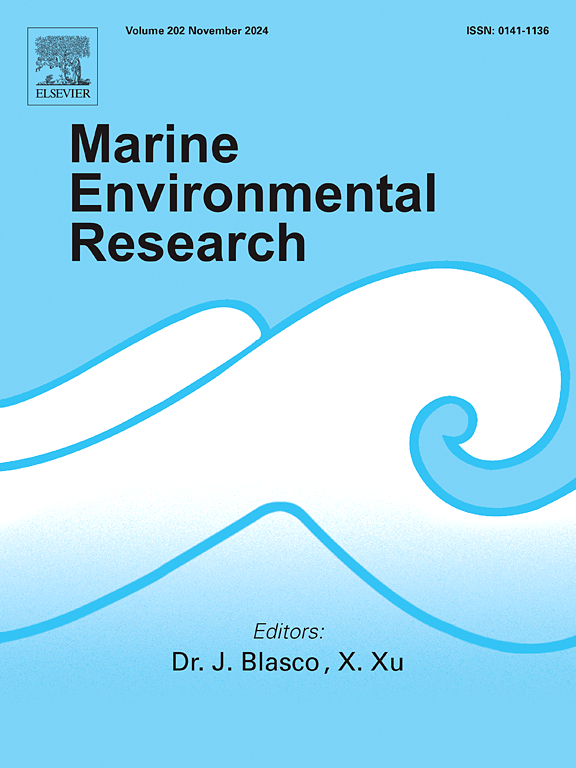Differentiating macroplastic and mesoplastic pollution on relatively clean beaches of central Philippines
IF 3
3区 环境科学与生态学
Q2 ENVIRONMENTAL SCIENCES
引用次数: 0
Abstract
Marine plastic litter exposed to different environmental conditions have the tendency to break and produce smaller plastic debris that threatens marine organism, tourism, livelihood, and health. However, our understanding on the distribution of different sizes of marine plastic litter in marine environments is still limited. This study assessed macroplastic and mesoplastic pollution in eleven residential and five non-residential beaches in Isabel and Merida, Leyte, Philippines. Macroplastics were collected within four quadrats in a delineated 100-m transect line parallel to the shoreline. Sampled litter was then counted, weighed, and sorted into categories. Subsequently, mesoplastic particles were collected from the same quadrats where macroplastic were collected. A total of 562 macroplastic litter and 38 mesoplastics were obtained. Residential sites recorded higher macroplastic and mesoplastic density compared to non-residential sites; however, this is not statistically significant. Dominant macroplastics were sando bags (26.69 %), while mesoplastics are fragmented (50 %), white and green (58 %), and mainly composed of polypropylene (PP) (34 %) as confirmed by FTIR-ATR. The brand audit revealed that Rebisco and PT Mayora Indah TBK were the largest food packaging plastic contributors on the site. Clean-Coast Index classified 75 % of the study sites as clean to moderately clean. Contamination Factors also classified sites having considerable to moderate contamination of mesoplastics. Macroplastic and mesoplastic are not correlated in the area. The result of this study signifies the need to create strategies and strengthen policies to combat plastic pollution. Furthermore, there is a need for industry intervention to produce less packaging and collective effort to achieve plastic net zero.
区分菲律宾中部相对清洁海滩上的大塑性和中塑性污染
海洋塑料垃圾暴露在不同的环境条件下,有破碎的趋势,产生更小的塑料碎片,威胁海洋生物、旅游、生计和健康。然而,我们对海洋环境中不同大小的海洋塑料垃圾分布的了解仍然有限。本研究评估了菲律宾莱特岛伊莎贝尔和梅里达的11个住宅和5个非住宅海滩的大塑性和中塑性污染。在与海岸线平行的划定的100米样线上的四个样方内收集宏观塑料。然后对取样的凋落物进行计数、称重并分类。随后,从收集大塑性颗粒的同一样方中收集中塑性颗粒。共获得大塑性凋落物562个,中塑性凋落物38个。住宅用地的宏观塑性和中塑性密度高于非住宅用地;然而,这在统计上并不显著。FTIR-ATR证实,宏观塑料以散多袋为主(26.69%),中塑料为碎片状(50%)、白色和绿色(58%),主要由聚丙烯(PP)组成(34%)。品牌审计显示,Rebisco和PT Mayora Indah TBK是该网站上最大的食品包装塑料贡献者。清洁海岸指数将75%的研究地点划分为清洁到中等清洁。污染因子还分类了具有相当到中度中塑料污染的地点。大塑性和中塑性在该地区不相关。这项研究的结果表明,有必要制定战略并加强政策,以对抗塑料污染。此外,需要行业干预以减少包装和集体努力实现塑料净零。
本文章由计算机程序翻译,如有差异,请以英文原文为准。
求助全文
约1分钟内获得全文
求助全文
来源期刊

Marine environmental research
环境科学-毒理学
CiteScore
5.90
自引率
3.00%
发文量
217
审稿时长
46 days
期刊介绍:
Marine Environmental Research publishes original research papers on chemical, physical, and biological interactions in the oceans and coastal waters. The journal serves as a forum for new information on biology, chemistry, and toxicology and syntheses that advance understanding of marine environmental processes.
Submission of multidisciplinary studies is encouraged. Studies that utilize experimental approaches to clarify the roles of anthropogenic and natural causes of changes in marine ecosystems are especially welcome, as are those studies that represent new developments of a theoretical or conceptual aspect of marine science. All papers published in this journal are reviewed by qualified peers prior to acceptance and publication. Examples of topics considered to be appropriate for the journal include, but are not limited to, the following:
– The extent, persistence, and consequences of change and the recovery from such change in natural marine systems
– The biochemical, physiological, and ecological consequences of contaminants to marine organisms and ecosystems
– The biogeochemistry of naturally occurring and anthropogenic substances
– Models that describe and predict the above processes
– Monitoring studies, to the extent that their results provide new information on functional processes
– Methodological papers describing improved quantitative techniques for the marine sciences.
 求助内容:
求助内容: 应助结果提醒方式:
应助结果提醒方式:


